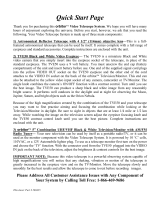
form some additional image processing to bring out subtle details or to make
the image appear more pleasing overall.
Both software applications are a recommended addition to any astro-imagers
arsenal of image processing software.
Getting Started During Daylight
We recommend using the SSVE for the first time during the day. This way,
you can become familiar with the camera and its functions without having to
stumble around in the dark. Set up your telescope and mount so the optical
tube is pointing at an object at least a couple of hundred feet away. Insert an
eyepiece and focus as you normally would.
To obtain first images with the SSVE, follow these step-by-step instructions:
Plug the 9v Power adapter into the SSVE. 1.
Plug the RCA composite output from the SSVE into your viewing device 2.
(TV, DVR, VCR, Camcorder).
To connect the camera to the telescope, simply replace the telescope’s 3.
1.25" eyepiece with the camera. Make sure the securing thumbscrew on
the focuser drawtube is tightened after the camera is inserted.
You will now need to refocus the camera for the centered object. Focusing 4.
will be the hardest thing to learn in the initial stages. If the daytime image
brightness is still too bright to produce an acceptable image on your
computer screen, you may need to stop-down the aperture of your tele-
scope.
Look at the 5. Live Video Window on the screen and adjust the focus knob
accordingly to determine best image focus.
Note: The camera’s field of view is fairly small. It is approximately equivalent to
the field of view through the telescope when looking through a typical (i.e. not
wide-field) 5mm Ultrascopic eyepiece.
Image orientation can be changed by rotating the camera within the 6.
focuser drawtube. Simply loosen the thumbscrew on the drawtube and
rotate the camera until the desired image orientation is achieved. Retighten
the thumbscrew on the focuser drawtube when done. You may need to
slightly refocus (using the telescope’s focus knob) if the focuser drawtube
has moved a bit inward or outward when the camera was rotated.
If you have attached a VCR, DVR or Camcorder you can now record a 7.
video of the live view.
You have now taken your first images with the SSVE! This simple method
of imaging is exactly how the camera is used to capture terrestrial subjects
during daylight hours. Close-up images of birds and other wildlife or faraway
vistas can all be obtained in this way with the SSVE. Solar images can also
be taken during the day with an optional
full-aperture solar filter over the front of
the telescope.
Take some time to use the camera dur-
ing the day to become familiar and com-
fortable with its basic operation.
Astronomical
Imaging
Now that you’re familiar with basic cam-
era operation, it’s time to take the SSVE
out at night under the stars to capture
some astronomical images. We recom-
mend starting with the Moon, as it is
easy to acquire into the camera’s field
of view, and typically does not require
stacking of multiple exposures as plan-
etary images do.
Imaging the Moon
Imaging the Moon is much like imaging
terrestrial objects during the day. Since
the exposure is very short, it is not criti-
cal that the telescope be precisely polar aligned.
When the moon is past half full, it is hard to get detail due to the tremendous
glare off of the lunar surface. Most detail, even on a sliver of a moon, will be at
the terminator (that tiny thin line between the shadow and light, see Figure 2).
To get more of the moon in the image, a focal reducer will need to be used.
For close-ups of craters use a Barlow lens (see “Using Focal Reducers and
Barlow Lenses”).
Imaging Planets
The best planetary images will be obtained by stacking (combining) many indi-
vidual images in order to improve image contrast, brightness, and detail.
A great way to obtain images for stacking is to take several seconds of video
of the planet, then break the video into individual frames for stacking. Since the
SSVE has a frame rate of 30 frames per second (NTSC) or 25 frames per second
(PAL), you can literally obtain hundreds of images for stacking in seconds! You
save time by taking one video instead of dozens of individual pictures!
Since you will be taking multiple images over a period of time, it is important
you have a decent polar alignment in order to keep the planet within the field of
view of the camera. To this end, having a motor drive (at least single-axis) will
Figure 2.
The moon’s surface detail
looks the best along the terminator.
Figure 3. (left) Jupiter live image.
(right) 500 frames Aligned, stacked
and enhanced using Registax
Image Processing Software. Image
taken with Orion 180mm Mak-Cass
telescope.







